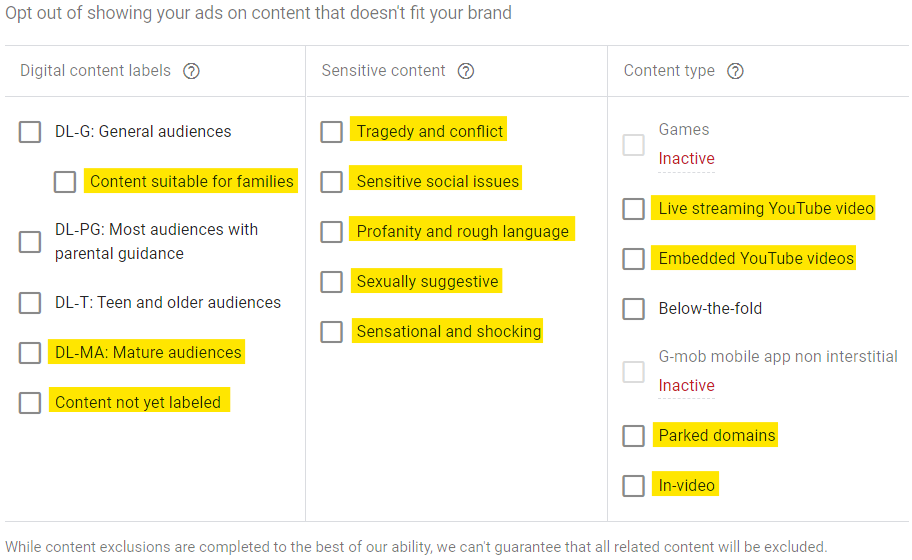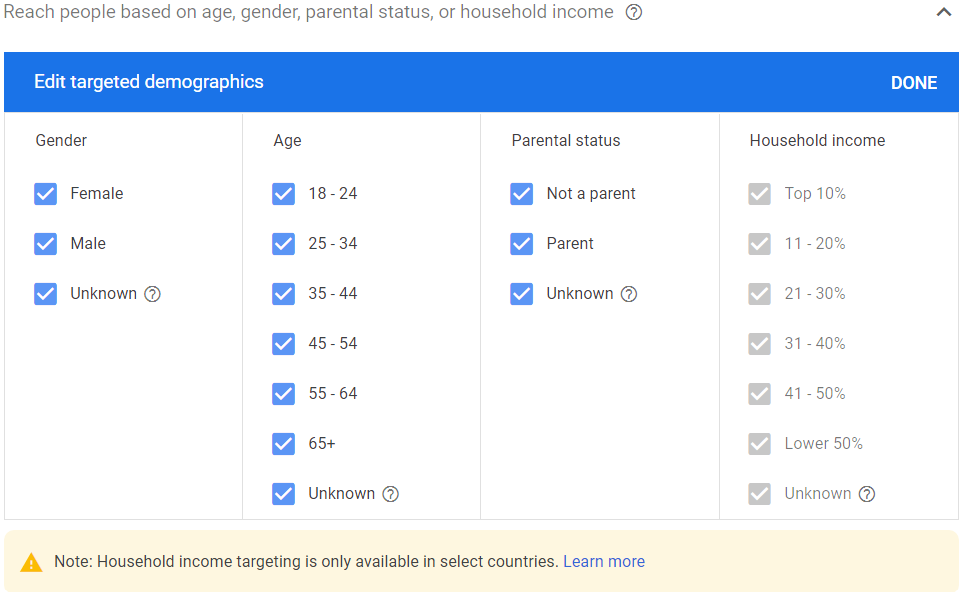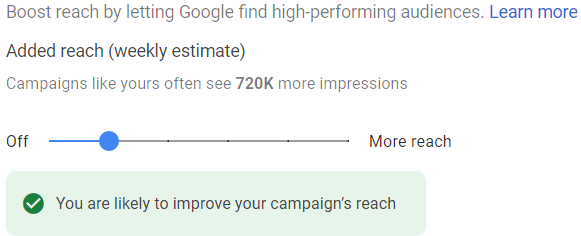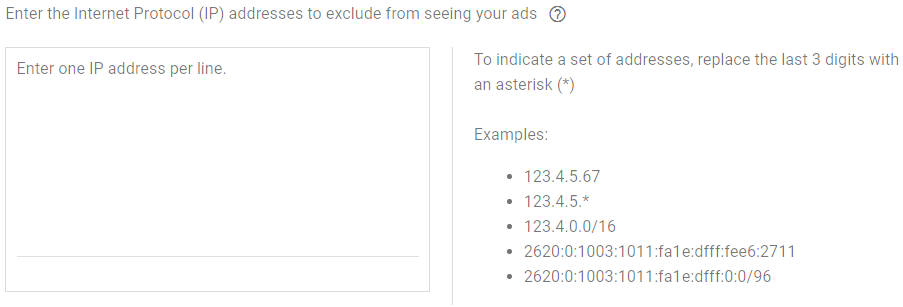Table of Contents
Purpose
Here we will tackle the main pitfalls to avoid when setting up a Google display campaign in Google Ads. These are not small mistakes. They can make a huge difference in your campaign efficiency. If you are running digital campaign and don’t see any business impact, the answer is maybe here. If your campaigns are run by an agency, don’t expect them to have gone through all these details, usually they don’t. The purpose is not to show how to set up a campaign from A to Z, there are plenty of existing tutorials out there on the Internet. Rather see it as a safety checklist or an advanced view.
Note: sometimes to get the below screens you need to click on “Additional settings”, “More options”, etc. as there are not shown by default (hum, that’s curious). But there are very interesting details to nail there. Remember that by default tools like Google will encourage you to keep possibilities (parameters) quite open; they will say it’s to allow for enough room for their algorithm to make optimizations and serve you best. I have no doubt that it’s better for their algorithm, but believe me, it’s not always better for your bank account. Check that you have nailed down the below, otherwise you might just be another ad fool.
Campaign set-up
 Location
Location

The location parameters can be used in more ways than the sole geographical limits. Think about the following ways to use it:
- Geography – That’s the obvious one. If you have a restaurant in only one city, it’s quite likely that you will want to advertise in this city only.
- Correlated data – In some countries there are correlations between living in cities (or specific regions, specific cities, etc.) and some other traits that can be interesting to you as an advertiser. For example in France city targeting can be used to target wealthy people as this is where healthy people tend to live. Thus instead of buying some third party data (with an additional cost and with a dubious precision) to target high revenue, use the city approach. Each country might have its specificity there, so think about what city or geographical areas tell you about people living there for your country.
- Volume and budget – If you don’t have enough budget to put enough media pressure on an entire country, a good way to go is to limit your campaigns to specific locations. You have to get a minimum number of repetition if you want your message to get noticed (and hopefully remembered). Remember that 50% of your so called impressions on the Google display network don’t even appear on the user screen. So, if your campaign forecasts show a frequency of 1 or 2 over a month, whatever your reach, it’s very likely that you are going to go unnoticed. So either change your parameters, or cancel the campaign (results will be the same, and you’ll have saved some money).
- Testing – That’s a more advanced tip but you can decide to A/B test the efficiency of a campaign by advertising on a specific location and compare the results with a location where you did not run any campaign (you need to make sure you have a way to measure this)
 Presence or interest
Presence or interest

Here’s another option to look at if you want to increase your campaign efficiency.
Unless you have a specific reason to target people who neither live nor regularly go in your selected areas, but only show interest for it, you should go for the conservative option and check “Presence: People in or regularly in your targeted location”. A case where you would keep the default option would be if you work in the tourism or travel industry and you need to target people looking for specific locations to go, and not living there.
 Ad schedule
Ad schedule

This one is hidden in the “Advanced option” section to open.
Days – Smart bidding strategies usually handle this quite well. But if you have any reason to believe that your ads should be shown on specific days only, just say it here.
Hours – Ok, why would you want your ads to run at 3.30am ? I don’t want to know who and in what state is going to be in front of his screen at this time. So again, minus exception (for example if you are selling drugs to help people with sleep issues), I’d highly recommend selecting hours for your ads to show – and yes even if your campaign is performance based as I think your ad is more likely to be shown and get clicked by real people at day than at night.
 Conversions
Conversions

Ok this one is extremely important, for 2 reasons:
- This is where you say which conversion(s) is to be taken into account in your campaign results. What the fool does? He keeps the default setting, and very likely there are many conversions included in the account-level “Include in ‘Conversions’” settings. Thus he artificially inflates the number of conversions (lots of them) and artificially decreases the cost per conversion. If you want to fool your managers, that’s a good way to go, if you want to fool yourself, that’s a good way to go too. Now if you want to be a little bit serious about it, just select the correct conversion actions (there can be multiple conversion actions if they make sense)
- If you are using smart bidding (for example target CPA), this is where you say which conversion is to be considered by the algorithm. Same logic as the previous bullet point. If you want to fool the algorithm and yourself, just keep the default setting, that way the algorithm will not focus on the conversion that matters to you, but to a bunch of conversions set behind the scene (in the Google Ads settings).
 Content exclusions
Content exclusions

Another important checkpoint, and there’s no one-size-fits-all answer: it depends on your product, audience and risk aversion. I’m just drawing your attention on these exclusions. I think most advertisers will want to exclude the content categories highlighted in yellow above.
2 remarks:
- Content suitable for families: it’s very likely that the websites behind are kids websites. So unless you are advertising to kids, I don’t think you want to appear on these websites (you will just be losing money).
- DL-MA: Mature audiences: we don’t have much information on what is behind “mature audiences”. On YouTube help section where we have this same option, it is written that this label applies to “videos that have some mature themes but that also have high artistic or educational value”… So it could be that the website behind have some suggestive content without being porn, in which case it could be a place to advertise especially if you target adult audiences. To be sure I’ll run some tests on this label and let you know what comes out…
 Audiences
Audiences

As there are many websites explaining all the existing options (plus you have the Google help center which is well done), I won’t go into details here. I just want to share a few advice:
- If you are really short on your budget, or beginning with display campaigns, don’t use audience targeting, instead use contextual keyword targeting. This is where you’re likely to get the best results. It can be found below the Demographics block, under : Content targeting > Keywords > Content: Only show ads on webpages, apps, and videos related to these keywords (it’s not the Custom audiences Google is trying to sell to you). Yes, it’s quite hidden, I think Google doesn’t really like people to use this targeting. You’ll then have to enter the keywords that need to be present on the page you want your ads to appear on. With this method, you’re likely to have a lower reach, but of higher quality. And depending on your budget, it might be enough for you.

- If you are going with Audiences targeting, look at your existing Google Analytics or Google Ads data to understand which In-Market or Affinity Google audiences have best results on your site. Then target them again here. If you don’t have existing data, use your common sense. The trick is to find a good balance between enough audiences so Google can optimize among them, but not too many audiences so your budget doesn’t get diluted among all these. As a rule of thumb, I’d say use a max of 10-15 in-market audiences, and 3-5 Affinity audiences. But that also depends on your other parameters, your budget, campaign duration, etc. Note that you’ll have the option to add or stop audiences once the campaign is live.
 Demographics
Demographics

No one-size-fits-all answer, it depends on your target audience, but use this functionality to narrow down your audience.
Remarks:
- It’s not 100% accurate, it’s not because you select 25-34yo only that your ads will only be shown to 25-34yo in real (digital) life
- What about “Unknown”? Well, if you are really conservative, uncheck the box. Now, doing so you will exclude people that are in your audience. If you want to get a proxy of how much of your qualified audience is hiding behind “Unknown”, look at your other Google data, like Google Analytics or your Google search campaigns. For example, look at the Age report, if you see that a lot of your incoming and qualified traffic is labeled “Unknown” there, then you might just want to target them on the Google Display Network. On the contrary if you have very few “Unknown” visits and/or these visits are highly unqualified (high bounce, no conversion, etc.), just uncheck the box.
 Targeting expansion
Targeting expansion

This one’s tricky. I’d recommend to use it if:
- You need to find a bigger audience, either because your target audience is small, or because you have a lot of budget to spend
- And if you are not a control freak of where your ads appear (which I am). Indeed in their help section, Google specifies: Automatic targeting results in new placements, so it’s suitable for advertisers who don’t have strict brand guidelines about where their ads appear. They say it won’t overwrite placement exclusion lists, but it’s not clear if it will override the Content exclusions categories set above.
If you decide to activate targeting expansion, I would put the cursor more on the left than on the right.
Once the campaign is set-up
 Frequency management
Frequency management

That the frequency feature is not proposed by default during the set-up phase is a pure joke. So, once your campaign “is set-up”, in your Google Ads account, select your campaign (you must be at a campaign level), go to the Settings tab, and look for the Frequency management box.
Honestly, I don’t see when you would want to keep the default set-up “Let Google Ads optimize how often your ads show (recommended)”. Typically that leads to the user seeing your ad 10 times a day for weeks or months because he went once on your website. This is annoying for the user, bad for your brand image, inefficient and a waste of money (do you need more arguments?).
So just click on “Set a preference”. There is no one-size-fits-all situations here. It depends on your campaign type. Put yourself in your customer’s shoes, take into account the media reality, and set a frequency.
Let’s take the retargeting example. I believe most retargeting works as a reminder, ie “Remember you were looking for this pair of shoes but did not finish your purchase?”. And maybe there’s a good reason why the user did not buy it: maybe he bought it elsewhere or doesn’t want it anymore (in this case no need to chase him 10x a day during 6 months), or maybe he jumped onto something else and still plan to buy it one day – and this is where smart retargeting comes into play and can be efficient. Then how many times do you need to show your ads to this customer who is still eager to buy your shoes? One banner a day is already enough, I would even say that once every other day is good. Ok so let’s say you want that your customer sees one banner every other day. You can set it to “Manage impressions for the whole campaign to 3 per week”. Now remember that only ~50% of your impressions are visible (shown on the screen), so you need to set it to 6 times a week. The issue is that 6 times a week means it can be shown 6 times during 1 day, then 0 time the next 5 days. Sweet. So you will be better off setting it to 1 per day. This time the user will see you ads once every other day (because of the visibility ratio). That, in my opinion, is a good set-up (not sure all agencies go into these types of consideration). Now on top of that there’s the retargeting window (which is set at the audience level, not on this page). If you are a B2C company, 30 days should be enough (maybe even less), but if you are a B2B company with long purchase cycles, you might want to extend your retargeting window a lot more (6 months and above).
 IP exclusions
IP exclusions

Same, this block can be found under the Settings tab at a campaign level.
If you want to prevent your ads from being shown to specific IPs (and save money), here’s where you do it.
Note:
- It would be nice if fraudulent bots would share beforehand the IP they use so we could just exclude them here. Unfortunately they don’t do this.
- Some recommend that you exclude your office IP to prevent coworkers from clicking on your ads and eating some of your budget. It could be useful if you are a very big corp. Now a big drawback to this is that your own company (and yourself as a digital manager) won’t get to see its own ads, which is very important for team spirit, from a marketing point of view, but also to somewhat control how your ads appear in real (digital) life. So, I’m not a big fan of this exclusion, but know it’s there.
Once the campaign is live
 Placements
Placements
Once your campaign is live, it’s not over. If you don’t have any whitelist, your ads will show on a lot of crappy websites (ie of very bad quality, not brand safe or even fraudulent). See the below the screenshot for yourself. That’s the top 5 placements of a campaign ran in France on one in-market segment. All 5 are very bad websites or app.

So, you need to check this – first daily, then regularly. Go in the Placement > Where ads showed tab, and exclude the websites or app that don’t align with your brand (or ask your agency to do it…). That’s painful, yes, but if you don’t do it you will end up spending a large portion of your budget inefficiently and just be another ad fool.
The best way to proceed is by building dedicated exclusion lists that you will be able to apply to other campaigns easily. To do so, go to Placement exclusions lists that you can find under Shared Library in the top Tools & settings menu.

Once you have your list of websites to exclude, you can apply it to your campaign in the Placements > Exclusions tab.
